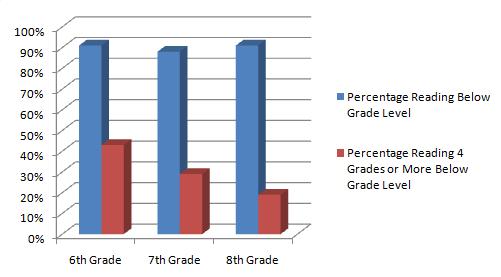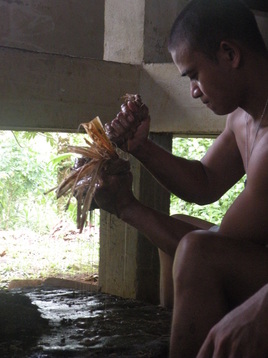 Squeezing Sakau in Hibiscus Bark _ First of all, my apologies for the delay in this post. Like most people, things were busier than normal around the holidays. I promised at the end of my last post that my next entry I was going to take a break from writing about education and instead discuss something cultural. As I was looking for cultural topics to write about, it hit me again that I have become so accustomed to the culture here that it’s difficult for me to recognize how remarkably different this place is compared to America. I suspected that the holidays would present many new traditions and customs that I have not confronted yet. My suspicions were confirmed when attending several local Christmas parties. A major part of Pohnpeian culture is sakau (pronounced sa-cow). Also known as kava, this drink used to be a ceremonial drink only available to the highest of the traditional leadership, but now is consumed by 70% of Pohnpeians, with many drinking it daily. It’s rare to go more than a mile without seeing the sign “Mie Sakau” (We have Sakau). The drink’s main effects are making the consumer very relaxed and tired, producing not exactly a “high” but more of a total-body lull. Subjectively, I believe the widespread drinking of sakau is not as bad as alcohol. Take for example how it affects driving capabilities. We all know that driving drunk can lead to disastrous consequences. Driving under the influence of sakau however is more funny than dangerous. The average speed of a sakau driver is 1-3mph. I have passed cars going this slow more times than I can count. As you can imagine, when a sakau driver crashes into a tree, he falls asleep, wakes up the next morning, and goes about his merry way. This Christmas I had the chance to try sakau. Sakau is consumed across many islands in the Pacific, but is unique to each island. Therefore, you often hear about the preparation of “sakau en Pohnpei,” i.e. Pohnpeian sakau. It is prepared by crushing the roots of the kava plant. In almost every nas in Pohnpei (the traditional huts) there is a flat piece of basaltic stone for the preparation of sakau. The root is pounded with rounded river rocks then some water is added. The mushy root/water substance is then packed into the bark from a hibiscus tree. Consequently, it is twisted until the liquid substance is squeezed into a communal coconut cup when it is ready to drink. The substance is viscous, thanks to the hibiscus sap. I was slightly concerned about trying sakau because I heard of a non-local having his tongue go numb for three months and having to talk with a lisp after drinking sakau. I wanted though to try it, at least to say I partook in a central element of Pohnpeian culture. I only took a large sip but it was unlike anything I have ever tasted. Immediately, I felt a numbing/tingling sensation on my lips. I was warned that many find the taste absolutely disgusting. It looks like muddy water, and kind of tastes like that as well, but I didn’t find it that dreadful. The numbing sensation lasted for about ten minutes. I never had a lisp though and wasn’t concerned the sensation would remain for long! While I’m glad I had the chance to try sakau, I’m concerned over how dramatically it impacts the Pohnpeian people. I have read that it has no addictive properties, but many locals are obsessed with sakau and have to drink it every day. Whether that qualifies as an “addiction” is a matter of opinion. I have no hard evidence to support this, but I strongly suspect that the consistent consumption of sakau is disturbing normal brain functions. Those who drink it daily seem to function even slower than normal and overall the sakau culture is a large contributor to the general snail-like pace of all proceedings in Pohnpei. All that said, sakau is a major part of Pohnpeian life despite the diminished impact of traditional culture and will likely remain that way for years to come. This weekend, I am looking forward to experiencing the Pohnpeian New Year. Apparently, things get pretty crazy – New Year is a big deal. So this year say “Parakup Mwao” (Pear-a-cup Mwow) – “Happy New Year” in Pohnpeian. On the work side of things, I had the chance to tag along with John and meet Governor Ehsa (the Governor of Pohnpei) the week before Christmas to discuss our education project and learn more about opportunities for potential funding. We also have been busy writing grants to the Australian Embassy and developing our iPad program further. I’m looking forward to getting back in the schools next week and getting started with our program! After talking with some relatives and friends back in the States I have been alerted that more pictures are necessary! Click here for a random collection of shots from November and December!
 Squeezing Sakau into Communal Coconut Cup 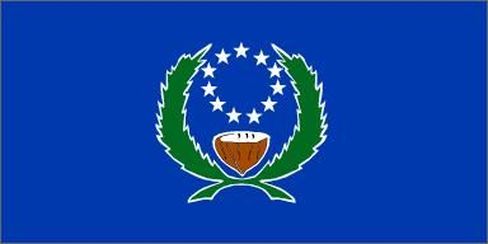 The Flag of Pohnpei - notice the communal coconut cup for sakau front and center
 __ The world has 6.8 billion people. Pohnpei, a tiny island in the middle of the Pacific Ocean, has a population just under 36,000. I’m willing to bet a large sum that the vast majority of you probably first heard of Pohnpei through my coming here. I know this because out of the probably over 100 people I talked to about my plans to serve here, only one person had ever heard of Micronesia. Indeed, in the world of current affairs, Pohnpei and Micronesia are not at the top of the Google search. When discussing how to fundraise and effectively solicit funding for our various projects, one of the main questions I have proposed is how do we get people to care about this tiny island? There are many possible answers to that question. The first that comes to mind is obvious - “these are people too – why should they receive any less attention or resources just because they live on a small island?” This is perhaps the best answer. When it comes to our education projects however, I have a special answer to why Pohnpei matters. In the developing world there is an overwhelming lack of educational resources. Only the extraordinary students will flourish and have a chance to further their education at the collegiate level or beyond. Throughout Micronesia however, this is not the case. Thanks to the US government, students here have the same privileges found on Native American reservations – access to a free education through the graduate level. This isn't written anywhere, but the number of scholarships available is immense, to not just the exceptional students, but the average and below-par as well. There are not many places in the world where the youth have this much access to a free college and graduate school education. The tragedy though is the amazing opportunities available to these students are regularly wasted. When students do take advantage of these scholarships and go to college, they often face so much remedial education that they drop out after a semester or flounder and go to school for six years before their funding runs dry. Of course there are exceptions to this, but this is the general trend. If these students managed to catch up with their reading proficiency, developed an intellectual curiosity, and pursued further education, the sky truly is the limit. It all starts though with bringing these kids up to speed so they are reading at or above grade level. We have a program in place that will make a difference in the lives of these students. The entire MAHI team has a sense of urgency that is palpable. It’s exciting to be part of this movement to help improve the education system here on Pohnpei. This is all a very, very slow process, but we are in this for the long haul. Would you like to join the movement? MAHI International is supported solely by generous individuals. Click here to learn how to make a gift! There's nothing much worse than wasted talent and opportunity. If we follow the status quo, nothing will change and this failed system will continue to produce students unprepared to continue their education. With support, we can buck this trend and change lives, generating students with an extremely bright future taking advantage of all the opportunities presented before them. I recognize my last few posts have focused on education - I promise my next post will be focused on my interactions with the culture and my experiences in and around Pohnpei!
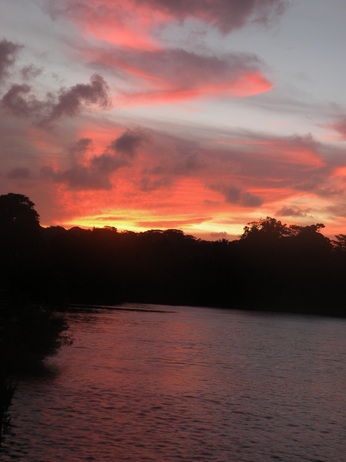 Recent sunset on the outskirts of Kolonia
 John introducing the dictionaries In the public eye, there is a clear distinction between non-profit organizations – faith-based or secular. The former engage in proselytizing activities while the latter focus on providing basic human services or raising awareness for a cause. Often however, the distinction is not so black and white. MAHI International is one of the organizations that falls in the gray area. Described as a “Christian-driven” organization, MAHI focuses on providing for the needs of the islanders, in areas such as healthcare, education and energy. From a personal perspective, I believe sharing the Gospel is one of the most valuable services you can provide. In the same breath, I believe it’s possible to live out the Gospel by helping others in different ways. MAHI has done this by donating beds to a hospital, working to improve literacy in the schools, and installing solar panels on outer islands, just to name a few. This reflects one of my favorite quotes from St. Francis of Assisi: “Preach the Gospel at all times and when necessary use words.” This past Wednesday, the MAHI team assisted in the delivery of new dictionaries donated by the Rotary Club to all 8th graders on Pohnpei, visiting over 15 schools. Many of the kids were absolutely stoked to receive their early Christmas present. In one school, the teacher told all her students on Monday that they needed to have a dictionary by Friday. We asked how many had purchased one yet – we saw no hands. Shortly thereafter, the teacher said we were “sent from above!” That wasn’t the first time I have heard such a comment. Indeed, as a Christian-driven organization fulfilling secular needs, I always smile when I’m reminded that we are doing God’s work. While it would be great to hand out Bibles, the majority of these students are reading three grades or more below grade level, as found by our student reading level assessments. Mind you, that assessment was only testing if the student could read the words – comprehension wasn’t even a factor. Distributing dictionaries won’t educate these students and send them to college, just like handing out Bibles won’t immediately lead to spiritual revival. Both are only mere steps in a long journey. I went to college in a campus that can fairly be defined as liberal, like most college campuses. Every year the Gideons came to town and handed out free pocket Bibles. I was always excited to receive a free Bible, but was disappointed to see other students take the Bible and throw them out, or openly ridicule the people distributing them. While in theory handing out “the good Word” is never a bad thing, it was obvious that it was going to take a lot more than handing out a book to convert anyone that day. Similarly, we have a lot more work on our hands to combat illiteracy on Pohnpei than just handing out dictionaries. There is no silver-bullet solution, but these dictionaries are another tool in our arsenal. We are moving forward in our education program, working out logistics regarding our community night with all the schools, where we plan to present all our results and galvanize support for education among the parents and community leaders. The Christmas spirit is in the air, which is weird for me given it's over 80 degrees every day!
 With all the 8th Graders at Pohnlangas Elementary School 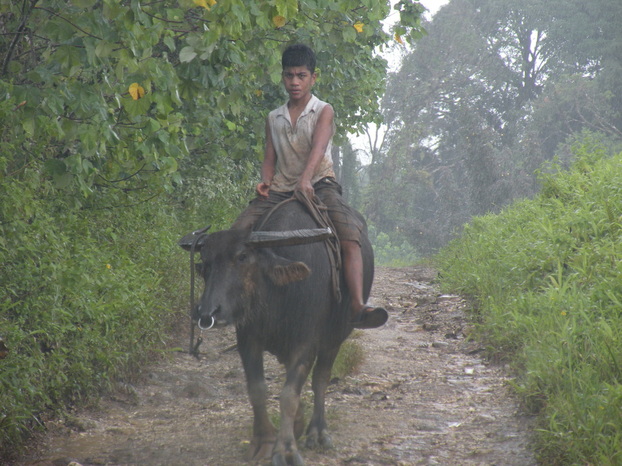 A little roadblock on the road to Salapwuk Elementary School
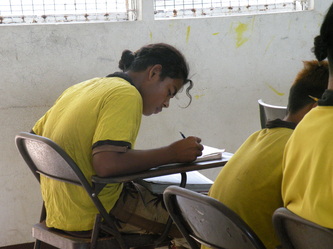 A student working at Sekere School The answer for every single issue in our world is simple: education. That might seem like a broad statement, but try to think of a problem that can’t be solved by an educated citizenry. Most issues are extremely complex and it is foolish to seek a silver bullet solution. However, it is imperative we recognize how crucial it is that the children of today know how to think critically and express their beliefs and opinions through oral and written mediums. The future will be built upon science, math and engineering, while we will progress through our ability to read and write. Education opens up a world of possibility if only we hold high standards and recognize our limitless potential. I am not familiar with any statistical study proving this, but I believe that the area most critical to the success of a school or education as a whole in a selected area, is the presence or absence of a culture of achievement. If the standards are high at all levels – government administration, school officials, teachers, parents, community leaders and students – success is inevitable. Again, that might seem broad or simplistic, but after spending four years in an environment with high intellectual standards, it’s hard to ignore the lack of such standards here in Pohnpei. I want to be crystal clear on one thing – these students, including the ones who are extremely behind, are not dumb. They are very industrious, creative and downright tough (I have yet to see a Pohnpeian kid cry, despite witnessing some nasty falls). They are simply the products of a failed system. The institutions and traditions that make up this system are deeply entrenched and steeped in a culture of ambivalence. Working within this system has been a challenge to say the least. God is no doubt teaching me the importance of patience (over and over and over). Despite any frustrations, I have enjoyed working with the kids conducting the student reading level assessments. Many times after finishing the assessment I would encourage the student to read more, adding “Knowledge is power!” It might be a bit corny, but it’s true! When I say “knowledge,” I’m not referring to knowing dates wars started and what an old white guy said (though as a history buff, those are good things to know!). For these kids, “knowledge” is reading proficiency. Here’s how it goes for far too many Pohnpeian students: - Enter high school 3-4 years behind in their reading level
- Get pushed through high school, being lucky if reading at an 8th grade level at graduation
- Enter COM (College of Micronesia) if pass entrance exam
- Face far too much remedial education at COM, become discouraged and drop out after less than a year
Of course this isn’t the course of events for every Pohnpeian, but it is certainly a notable trend. If these kids enter high school 3-4 years behind, unless they are lucky enough to run into an amazing teacher somewhere, they are on a track for failure. Here’s the problem. Now we’re going to do something about it. We visited all the principals of our adopted schools this week presenting them our report which included our recommendations derived from our teacher and principal evaluations and the results from our student reading level assessments. The principals were especially excited to get each student’s reading level. Now that they know what level each student is reading they can work with each student appropriately, giving him or her the proper amount of attention and assigning the proper resources. Indeed, knowledge is power. (Side note: I’m planning on posting on the blog once a week, on Thursday or Friday – so to most of you who read this, on Wednesday or Thursday. Occasionally I’ll post more often, and I might be delayed in posting if the Internet goes down like it did for a while this week. Just an FYI.)
 A quote from Dr. Benjamin Rush, founder of Dickinson College, on the wall in the Dickinson Admissions Building
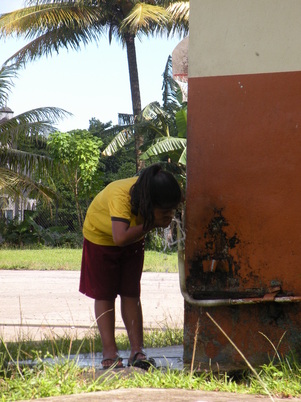 A Pohnpeian Water Fountain After much contemplation, research and analysis we finally have a plan that I am confident will make a major difference in helping the schools we have adopted. I have already posted the results from our time in these schools in case you were curious of their current status. Our plan consists of the following three-prong approach, with the initial goal and how we intend to accomplish each goal: Create a collaborative community and school partnership- Hold a community night at each school, inviting students, parents, teachers, administrators, and traditional leaders of the community. The focus will be on the importance of education for the future of each child, the community, Pohnpei, and the world.
- Work with each school’s PTA, introducing new strategies for parents to support and encourage their children’s education.
Strengthen leadership at the administrative level- Encourage and support school principals by having one-on-one appointments with the principal and Mr. Miller Benjamin, MAHI International’s Senior Educator. These meetings will occur on a five-week rotating schedule, with Mr. Benjamin meeting with one principal a week.
- Hold a second principal workshop in January with the five principals of the schools we have adopted.
Teach English and introduce new strategies to the teachers- Use tablet computers installed with English learning software to improve each student’s reading level. We will be visiting one school a day (a school for each day of the week) and teaching in grades 6, 7 and 8 for one period. This will consist of a 20-minute lesson from the MAHI International Education team, followed by 30 minutes of the students working on the tablets, completing work related to the lesson for the day. The teachers will also complete this lesson so they can become familiar with the teaching strategies presented in the tablets software.
- Hold a two-hour workshop once a week with all the teachers at the school. This will occur on a five-week rotating schedule. Each workshop will focus on a specific topic that is integral to successful teaching (ex. lesson planning, classroom management, etc.)
This is the basic outline of our plan, as each step obviously involves more details. So how did we get to this plan might you ask? Well let me start with the first two parts, creating a collaborative community and school partnership and strengthening leadership at the administrative level. I stumbled across a few pamphlets called the “Micronesian Counselor” published by MicSem and authored by Francis X. Hezel, SJ, who has been serving in Micronesia for decades. I read Hezel’s conclusion that throughout his years of observation, the only schools that are successful are ones who have community support and strong leadership at the principal level. My past experience speaks to this, when I interned at the White House Center for Faith-Based and Neighborhood Partnerships at the US Department of Education, whose chief goal is to stress the importance of community support in education. I traveled across the country and witnessed firsthand how critical community support is for a school to be successful, and how difficult it is to cultivate this relationship. Reflecting on my own brief couple of months in the Pohnpei schools, I couldn’t help but agree with Hazel. There are many obstacles in the way of achieving these two goals of which are the most absolute necessity to achieve any sort of success, but I believe we are at a great advantage knowing what is most important to produce any sort of long-lasting change. The last part of our approach, teaching English and introducing new strategies to the teachers, took a lot of deep thought. In case I haven’t made it clear, English is the second language to every child in these schools as they are first introduced to their native tongue of Pohnpeian. The vast majority of their teachers have graduated from the College of Micronesia with an AA degree, where all classes are taught in English. Despite obtaining their degree, many of the teachers are not comfortable with their English skills. I witnessed several teachers teaching English lessons incorrectly. Simply put, many teachers are just not qualified to teach English. Mr. B was the principal of the local SDA School here for the past 19 years. He oversaw its rapid growth, almost doubling in size and becoming one of the best schools on the island. I asked Mr. B why the SDA school was so much more successful than the public schools. While there are many possible answers to that question, his immediate response was because they were being taught by native English speakers. The majority of the SDA teaching staff is composed of SMs (Student Missionaries), most of whom are taking a gap year in college to teach here in Pohnpei. Ideally, we want to bring volunteers to all the public schools, whether from Peace Corp, World Teach, or through MAHI like myself. While there are many of these teachers throughout the island doing great work, there simply are not enough. Our solution: tablets. We are in the process of obtaining tablet computers installed with English learning software. Most of these students have never worked with a computer before. There are countless studies which demonstrate the positive effect technology can have in the classroom, particularly with tablet computers and especially in developing countries. If this technology is used appropriately, it is virtually guaranteed that students will make tremendous gains. Besides the new medium the tablets offer, I also believe we will be successful by who we are bringing into the classroom. Mr. B is an extremely experienced educator and a respected voice throughout Pohnpei. Over the course of all our evaluations and assessments all he could talk about was teaching; he clearly wants to just get back in the classroom and teach. Indeed, the first time I met him, only a day after stepping off the plane, he informed me that we were going to go teach the next day. Fortunately there was a scheduling conflict so my jet-lagged self could get some sleep! I’m really excited to see Mr. B back in his element, doing what he does best. Whenever Mr. B needs a break, I’m sure I will get the opportunity to teach as well. I have no illusions of being even in the same ballpark as Mr. B when it comes to teaching, but I’m looking forward to giving it my best shot. The reason I’m most interested to try is this – I’m a menwie (i.e. a foreigner, a white guy). Every time I visited the schools I was always looked at like I was an alien creature. Normally if you are caught staring at someone in the States you look away immediately, hoping that your staring subject didn’t see you. Here, they just continue to gaze. I just smile and say “Lelie!” (lay-lee-ah), i.e. Hello! I have no idea what to expect when I first try teaching, but I already have their attention, so I’m off to a good start! I’m sure with Mr. B’s tutelage I’ll be at least a somewhat competent teacher. So there ya have it – there’s our brilliant game plan for reform. Any thoughts? Suggestions? E-mail me! I would love to hear any feedback. You will surely hear more about how this plan is going, and how ultimately, true change cannot be imposed on the Pohnpeians - it has to come from within. I hope our program won't be an unwanted demand from an outsider, but rather a nudge in the right direction. Much more on this in future posts. Also want to wish a Happy Thanksgiving to everyone! It might not be Thanksgiving yet for you, but I’m 16 hours ahead of Eastern Standard Time! Surprisingly, Pohnpei doesn’t celebrate Thanksgiving despite celebrating virtually every other holiday known to man. Don’t worry, they celebrate Harvest Day on Friday (refer to my last post to see the ridiculousness in that!). For our latest adventure, Dale, John and I climbed to the top of Sokehs Rock (that big rock you see in the banner picture at the top of the screen). Despite some relatively sketchy parts, where a false step will lead to your ultimate demise, we made it out alive. I'm looking forward towards camping at the top eventually - the sunset and sunrise should be truly epic.
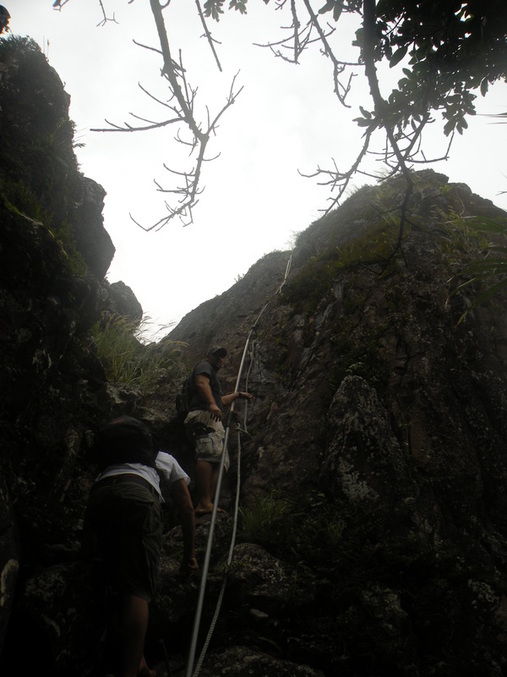 The climb up. Very thankful for the rope. 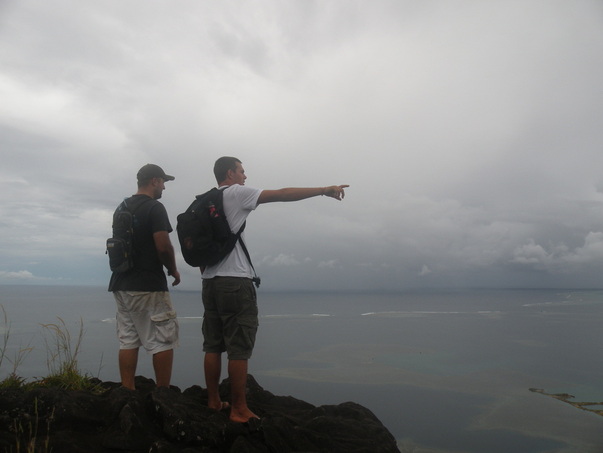 Pointing out atolls we have visited 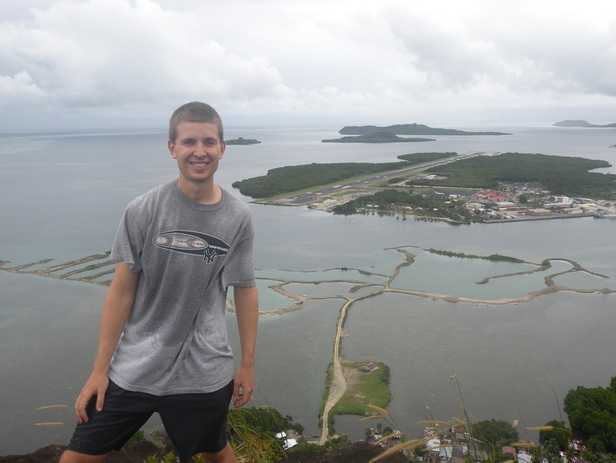 Was a pretty cloudy day so the visibility was poor. Can still make out the airport though!
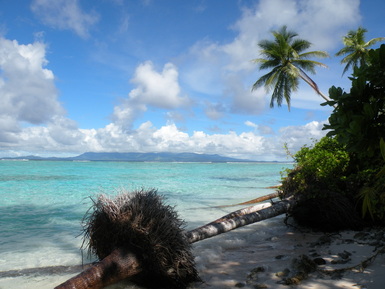 A view of Pohnpei from Ahnd Atoll I was introduced to an interesting theory this week regarding the slow pace of life in Pacific island communities. The theory states that there is a lack of urgency that pervades the culture in climates without winter, as people never have to prepare ahead for anything. Pohnpei would certainly fall into the category of being “winterless” as the daily low and high temperature for the day never vary by more than five degrees all year. Never does a Pohnpeian have to worry about being snowed in after a big storm, or plan when they want to plant and harvest their crops – every day is like the last and tomorrow will be the same. While I had read plenty about “island time” before I arrived in Pohnpei, the slow pace hasn’t really struck me until lately. Perhaps it has just been a bad week, but I have been particularly frustrated by how long everything takes. Take a normal meeting for example. A meeting that should take five to ten minutes often takes 30 minutes to an hour. People drive very slowly as well. The island speed limit is 25mph, but it’s rare to go more than a mile without someone driving between 5-10mph. Beyond just daily inconveniences there is no sense of urgency to solve any of the pressing issues present on the island. From healthcare to infrastructure, energy to education, every problem can be solved "lakkup" (i.e. tomorrow). Of course this is a generalization, but on the whole this is the culture of Pohnpei, and from what I’ve heard, all Pacific island communities. Given all of this it’s interesting to think that Pohnpeians, Micronesians, and all Pacific island communities have a lifestyle that is directly impacted by the weather. For those that don’t know, I come from a family that loves snow. No matter what the season, snowmen decorate the house. My brother still recalls the Blizzard of ’96 with childhood wonder and my father can cite snowfall records from the past century by memory. Indeed, he is legitimately a “snow expert” specializing in global snow cover. They were quite confused when I decided to live somewhere for a year where it has never snowed – ever. But I’m sure they would be overjoyed to hear that according to this one theory, which I believe holds some legitimacy, the world’s prosperity and development owes its existence to snow. As always, we have been very busy with our education program. We have a very exciting plan in store that I look forward to sharing within the next week or so. It has been a challenge to comprehensively address the great number of issues we found in the schools, but I am confident our plan will make a great difference for these students. This past weekend was a lot of fun camping on Ahnd (pronounced “Ant”). Check out some pictures of the island beauty and fishing heaven.
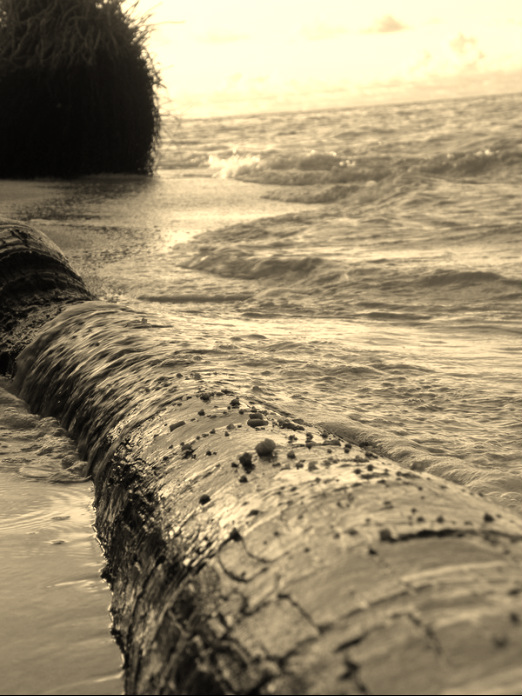 My favorite shot from the weekend: a fallen palm tree being lapped by waves at dusk.
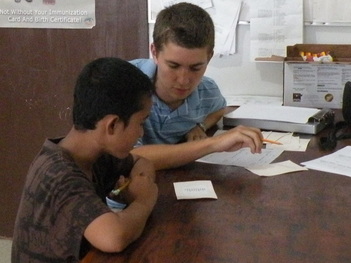 Conducting student reading assessments at Sapwalap Elementary School We have quite a challenge ahead of us.
Attached are the student reading level results with accompanying statistics.
It has taken quite some time to get all this data, but it is imperative that we know where we are before we start with our program. Tomorrow is Veterans Day, and Micronesians celebrate pretty much every holiday known to man, so we will get started next week. A bunch of us are headed to the outer island of Ant to go camping for the weekend. It will be difficult to get my head away from the large task in front of us, but a change of scenery is welcomed.
Despite the immensity of the challenge facing us, I know that our mission is crucial. The students here have more educational opportunities than most people in the world. The number of scholarships available to them are vast, if only they are equipped with the tools to achieve. Essentially, a motivated and diligent student in Micronesia can be educated through the graduate level for free. However, the average Micronesian student has many more challenges than their American counterparts.
Change will not happen overnight, but knowing how important our work is will certainly drive the entire MAHI team to persist throughout this great and worthy undertaking.
Pray for us!
 6th Grade Reading Level from one of our adopted schools (P=Primary, i.e. Kindergarten; PP=Pre-Primary) - Assessed 560 students in seven schools
- Average student is reading three grades below grade level
- 37 students are reading at Kindergarten level or below
We are very close to being done with our student reading level assessments. I’m excited to finally get all the results so we can actually start doing something to help. Unfortunately, tomorrow is yet another holiday (Constitution Day) so there is no school. Never thought I would say that!
Wednesday we will finish the assessments and I will post the combined results from all the schools. In the mean time, I just wanted to share this picture that screams “Pohnpei.” Mr. B and I stopped by this roadside store to pick up some water. There are these tiny roadside stores everywhere. The picture below is by no means out of the ordinary.
It’s funny to think that five weeks ago I would be shocked to see a bunch of kids running around naked or men walking down the street with machetes, and now it’s normal. There are many other things that fall in this category. Now, I’m used to driving on the other side of the road to avoid potholes, seeing two dogs do the dirty deed in the middle of the road is no big deal, and wearing zoris (i.e. flip flops) to formal meetings is the norm. It will certainly take time to adjust back to America!
Stay tuned for the reading level results!
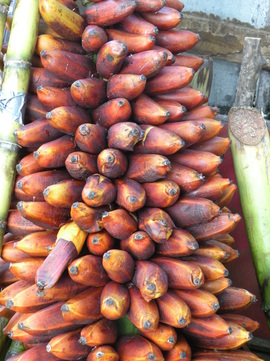 Local Bananas As previously noted, one of the most common questions I have received before I left for Pohnpei was what was I going to eat? I had read about local foods but didn’t really have a good answer, so I just said “food.” This is an interesting part of the world because there is food from many different cultures all in one place. So while there is some American food, there is also a lot of Japanese, Filipino and local food as well. I’m happy to report though that there are no fast food restaurants (or at least not chains). The cynical side of me says it’s only a matter of time before a McDonalds pops up – they’d make a killing. Most of my meals consist of budget-friendly courses like pasta and beans and rice. I have tried some new food for the first time though. The Japanese food I’ve tried has been really good. Today I ate somen, which is a cold noodle with an onion and ginger sauce. Most of the Japanese food I’ve eaten though has come in packaging, as everything in Japan comes in a package, or so I’ve been told. Among these are asparagus bread sticks, nutrition biscuits and this coffee-milk drink called Pokka which I’m slowly becoming addicted to. I’ve only touched the tip of the iceberg with all the available Japanese food. What I really was excited to try though was the local food. I have eaten plenty of fish, mostly Skipjack and Yellow Fin Tuna. I also prepared and ate a Surgeon fish I caught last week. I’m looking forward to fishing in a couple months when it is the season for my favorite fish, Mahi Mahi. With these fish though we haven’t just eaten the filets and thrown out the rest. As per local custom, the best part of the fish is the stuff most people toss in the trash can. I have eaten all parts of the fish head including the eyes and also the heart, sashimi style. Check out the video below to see how much I enjoyed that! Besides fish I have really enjoyed other local foods. I have eaten breadfruit, coconuts, papaya and many different types of bananas. Breadfruit is the most important food to the locals, as it has deep cultural meaning being the main staple food of the islanders. In Pohnpeian, breadfruit is translated as “Mahi” (pronounced “my”) – an interesting anecdote considering the name of our non-profit organization. Quick side story: The other day we were eating papaya and threw the seeds over the balcony onto some dirt here at the MAHI Hospitality Center. About five days later John was cutting the grass and knew well enough not to cut the papaya trees which were already about four inches tall. He said they will be taller than us in a few months and produce fruit a few months after that. It’s very easy to grow food in Pohnpei! My favorite local food is probably karat (pronounced “ka-rotch” – emphasis on the “ka”). It’s a short, thick banana probably three inches in diameter. You peel half off and eat it with a spoon. One of the great things about it is how it is ridiculously good for you. The numbers are staggering of how many vitamins it contains. I’ve heard numbers that it contains more than 3000% of your daily value in certain vitamins. Historically some have thought it was bad for you because it makes your urine bright yellow, while in fact it’s just caused from an overload of vitamins. John warned me this was going to happen, but it was pretty crazy when it did! I’ve also eaten different bananas prepared in a variety of ways, such as boiled, which I was told actually brings out more nutrients than if you eat them raw. My favorite thing I’ve eaten thus far has been dytuss (no idea of the spelling, pronounced “thai-toose”). You make it by smashing banana into flour, making bite size pieces, and deep frying the whole thing. I only had one but apparently at different potlucks there are whole platters. I’m looking forward to the day when I’m at such an event. Overall, it has been an interesting experience to try new foods, having no idea what to expect. There are plenty of more foods I am looking forward to trying, but I will definitely do my best to avoid all the high-sugar, processed foods that are the cause of an epidemic of diabetes, hypertension and other noncommunicable diseases on Pohnpei. Today is FSM Independence Day so there is no school, and most schools and government offices are taking off tomorrow (Friday) as well. We have been very busy with our education project though and are one school away from completing our student reading level assessments! We have been spending a lot of time brainstorming where to start in reforming these schools, focusing on how to create lasting and sustainable change. Stay tuned for the final results and our game plan for reform!
The local belief is that if you eat the heart of a Yellow Fin Tuna raw (sashimi) you will never get seasick again. I figured there was no harm in trying... And in case you were wondering, it tastes exactly like you think it would.
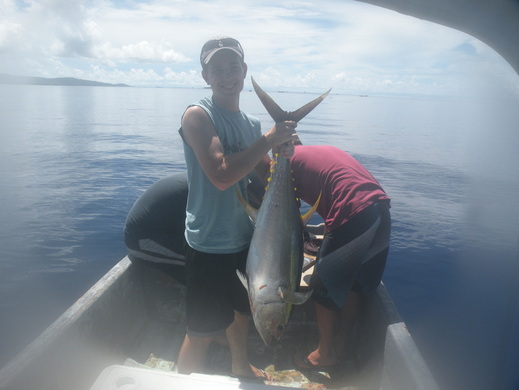 A 40 lb. Yellow Fin Tuna - the biggest catch I have been a part of...so far!
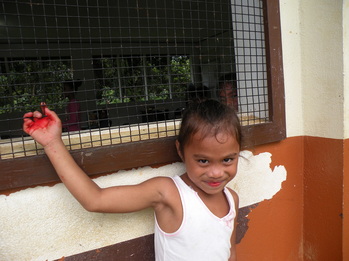 We are out of the classrooms this week as the schools have Monday and Friday off and Finals Tuesday-Thursday. We are taking this time to compile all our data collected in the schools so far and plan how we will attempt to reform the problems we have confronted. I thought I could take this break from reports in schools to write about nutrition here in Pohnpei. It’s no secret that the average Pohnpeian does not keep a healthy diet. Prior to colonization, they were subsistence farmers, eating a diet of fish, taro, bananas and other local food. With the drastic change in lifestyle has come a drastic change in diet. While there is still an abundance of fresh local food, the islanders taste buds now prefer ramen noodles, soda, Kool Aid, canned meats and turkey tail (which has 13x more fat than the rest of the turkey). As a result of these diet choices, Pohnpei and the other three states in the FSM have some of the highest rates of diabetes per capita in the world. It is not unusual to see individuals with limbs amputated from the disease.
One of the biggest issues is the lack of basic health education. MAHI has made efforts to bring this education to the islanders but obviously it is an uphill battle. I think the best way to paint the picture of the severity of the situation is a few scenes I have witnessed. On our first site visit, I saw the girl in the attached picture, licking her hands. Her hands were bright red, but it clearly wasn’t blood as it looked like some sort of powder. I asked John and he told me it was Kool Aid mix. Since that first girl I have seen countless kids walking around licking their hands. A common lunch is dry ramen mixed with Kool Aid. I have been told that kids die every year from renal failure as a result of this diet.
Another scene occurred when I picked up Mr. B the other day. A girl about ten-years old was walking to school drinking a can of soda. Apparently soda is a common breakfast. Perhaps the most shocking scene though was a parent giving her baby a lollipop to suck on instead of a pacifier. While this might invoke outrage, I don’t get the impression that this harm is done intentionally. I truly believe that many of the islanders, particularly the parents feeding their children, don’t know the negative effects of this diet, or at least the severity of the consequences. Compounding this diet is the lack of other basic health knowledge such as the importance of brushing your teeth and regular exercise.
It’s easy to look at the current problems and blame the islanders for their lack of knowledge. But if you look at the history, it’s difficult to blame anyone besides the United States. Prior to the US occupation of Micronesia, the islands were colonized by Spain, Germany and Japan. It wasn’t until the US flooded these islands with sweets that these problems emerged. After studying and spending some time on the Navajo reservation in Arizona, it is clear that Micronesians and Native Americans face many of the same issues. Ultimately, what they share in common is the curse of government handouts. This deserves another post or two, but I feel it is appropriate to put the complex issue of nutrition here in Pohnpei and throughout the FSM in the proper context.
One of the most common questions I received prior to arriving in Pohnpei and since is what I eat. I’m going to hold you in suspense until my next post, which includes video of me sampling a local delicacy…
For now, check out the videos below of some jumps off the Lehn Paipohn Waterfall this past weekend. Sorry mom!
|

















